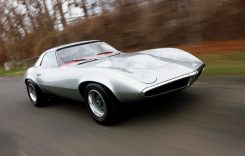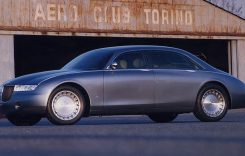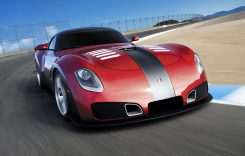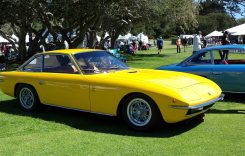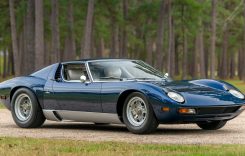Yamaha rattled some moto cages with the release of the 2010 YZ450F and its unique rearward-facing engine. But the unconventional YZ hasn’t proven dominant in either the AMA Motocross/Supercross series, nor has it fared well in Motorcycle USA’s annual 450 MX Shootout. For 2014 Yamaha aims to change this record with significant revamps to its YZ450F, including the first major overhaul of that rearward 450 Single. Yamaha invited MotoUSA to Zaca Station for two days of moto action, where AMA racer and MotoUSA test rider Chris See delivers his feedback on the new YZ.
One benefit of the original 2010 engine layout was the forward intake and airbox, which provide a straighter intake tract for the fuel-injected Single. The 2014 YZ enhances the intake with air box capacity increased by a claimed 265%. The air filter shape is also revised and surface area increased (the air filter located right behind the steering head, where a fuel cap would be in a traditional dirt bike). The added air volume rushes through an altered intake port profile, with the now 37mm valves one millimeter wider than the previous model. Intake cam profiles are also revised.
The 2014 Single sources a new piston, with a flatter crown shape for the four-valve head. The new crown profile increases combustion chamber volume by 0.9cc, and Yamaha claims combustion is improved for low to mid-torque feeling. A new surface treatment on the piston skirt also promises reduced friction.

On the exit side the valve diameter grows as well, up to 30.5mm from 30mm. And the YZ makes use of a wrap-around exhaust, the header rotating out the left side, to the front and terminating in the silencer, which is moved in closer to the center of the bike. Engine revisions tally up to the usual claims of increased power throughout the rev range – which is now increased by 250 rpm.
(Above) The new YZ mill is similar to its predecessor, with a strong bottom end pulling out of corners. (Below) The gap between second and third gear is shortened, widening the ratio between third and fourth. The goal is to make the YZ pull harder shifting to third and fourth.
“This thing definitely packs a punch on the bottom end,” notes test rider Chris See of the revitalized Single. “From a quarter throttle turn it definitely takes off and has a very strong mid-range that goes all the way into the top end. Much like the 2013 it does sign off a little bit on the top – but you definitely have to really push it up there to find it.”
Our test rider found the new YZ mill similar to its predecessor, with a strong bottom end pulling out of corners. The power curve wasn’t dialed to his liking, but fortunately Yamaha offers the GYTR engine mapping which allowed him to tweak the engine delivery to his preference.
“I wanted to move the power map to a more top end feel, so I slowed down the bottom end hit to where it was more usable,” explains See. “It was a better roll-on power, so it picked up in the mid and the top end and it helped me a bunch.”
As for other revisions to the engine package, Chris took note of the rerouted exhaust header: “With that wraparound pipe, during the moto you could feel the heat under you. I never had a problem burning my legs or anything, but you definitely feel the heat on your legs.”
He also noticed the revised transmission, as Yamaha alters gear ratios to enhance usable power. The gap between second and third gear is shortened, widening the ratio between third and fourth. The goal is to make the YZ pull harder in shifting to third and fourth – better matching the 450’s torque production. Other gearing changes include the final drive ratio, which adds another tooth to the rear sprocket (49 from 48), and a taller primary ratio (23/60 from 23/61).
“The new transmission had a way better feel compared to last year’s bike,” claims Chris. “The second and third gear being closer together, I definitely liked that. I could use third gear a lot more in the sweeper corners and roll on the throttle and it picked it up. I did notice from third to fourth gear that the bike sometimes lagged carrying the transition. But trying a one tooth-larger rear sprocket helped a considerable amount in bringing the gears closer together and giving me a more usable feeling.”
(Above) Centralizing mass remains one of the overriding concepts in this year’s revamp. (Below) An all-new frame features revised rigidity to improve handling. It also moves the front wheel closer to the center by 10mm, helping put more weight on the front.
The YZ clutch is revised for 2014, with 10% stiffer springs and clutch plate material. The transmission package also includes a new shift mechanism to smooth out gear changes, with new shift forks, lever and shaft as well.
“I did experience a few times between third and fourth gear the bike catching a false neutral, which made me slightly scared going into fast jumps,” admits Chris. “But the action of the clutch felt great – easy to pull but not overly tough. I did notice some fade, but could have been because of me being slightly clutch happy…”
The much-hyped rearward Single helps centralize mass – and centralizing mass remains one of the overriding concepts in this year’s revamp. The aforementioned exhaust change does its part, moving in closer to the center by a surprising 7.3 inches. The fuel tank scrunches closer to the center, despite increasing its capacity to two gallons from 1.6. And even the layout of the electrical components was considered with concentration of mass in mind.
An all-new frame features revised rigidity to improve handling. It also moves the front wheel closer to the center by 10mm, helping put more weight on the front. And that front wheel sports a new MX51FA tire, with claims of improved corner grip. The front axle is also new, 2mm broader and more rigid.
“The YZ feels very planted – it doesn’t feel like the weight’s too far forward or too far back. It feels like it’s right in the middle underneath you,” says Chris of the revised YZ. As for the front end changes, he reckons: “This bike is responsive to being on the front end. And you definitely have to get weight on the front end to get it to bite where you want it.”
Getting the rider weight up front was one of the complaints of the previous model, as the YZ feels broad and bulky – particularly at the radiator shrouds. This year’s more compact YZ claims slimmer ergos, with the bike 14mm narrower at the air cleaner ducts (behind the shrouds). But the ergos, while improved, didn’t eliminate the issue for our test rider.
“For me this bike felt like it had one position that was the most comfortable, which happened to be right in the middle of the bike,” says Chris. “For me I felt that it was rather uncomfortable to get up on the front of the bike in corners. Even with the bike being 14mm slimmer in the shroud area, it felt very wide and undesirable for me. The middle area of the bike when sitting or standing felt great, slim and comfortable, but in a weird way it almost locked you there. If I went to slide to the rear end of the bike my boots would get caught on the bottom of the seat and I couldn’t move. I did like that you had tons of options with bar placement. I was most comfortable with the rear position with the bar mounts in the forward position.”
Our tester gives a hearty thumbs up to Yamaha’s gas cap, discreetly tucked away underneath a flip-up front section of the seat.
Our tester gives a hearty thumbs up to Yamaha’s gas cap, discreetly tucked away underneath a flip-up front section of the seat. Considering an errant jump and protruding Husky 125 gas cap created some, ahem, painful issues for Chris last year – the smooth surface is a welcome change.
In the suspension department, Yamaha opts to not switch to the air-shocks adorning most of its competition. Instead the Tuning Fork brand sticks with its tradition Kayaba suspension – with revisions to spring rates and valving. Tweaks to the suspension components include a new surface coating on the front fork, with rigidity of the outer tube increased thanks to a change in the taper. Out back the shock reservoir layout is altered to mate with the few fuel tank and exhaust.
“For 2014 many of the bikes have air forks, but I am not a fan. So I really like that Yamaha stuck with the Kayaba suspension. For me it was awesome – I felt right at home and loved it right away,” says Chris, who dialed in the clickers to his riding style – preferring a stiffer front and softer rear.
“The rear end started out riding rather high in the stroke and would spike up in the stutter bumps, so I came in and turned the high speed adjuster a 3/4-turn out to slow it down. I went two softer on compression and also two slower on the rebound, which seemed to settle the rear end and feel stable and predictable. The front end was slightly soft in box stock form, bottoming out on bigger breaking bumps and when hard on brakes, so we added 10cc to the forks oil height, went two stiffer on compression and quickened the rebound two clicks. These settings felt most comfortable to me and I stuck with when the track was rougher toward the end of the day.”
Handling and chassis performance has improved overall by
Chris’ measure, even if the wide feeling up front isn’t eliminated.
Chris favors the YZ braking package, which is unchanged for 2014, saying: “The front brake wasn’t super strong, which for me was just perfect – not too touchy, so you could grab a handful and not worry about the front end tucking or getting away from you. The rear brake got a bit mushy during a long moto, but it’s no worse than most bikes and is just something I would like to see improved.”
Handling and chassis performance has improved overall by Chris’ measure, even if the wide feeling up front isn’t eliminated: “For me the problem with the 2013 YZ was that I couldn’t seem to hit a line the same way twice. It was tough for me to ever get comfortable. For 2014 they definitely made refinements that fixed a lot of the 2013’s quirks.”
Styling for the ’14 model year mates with the YZ’s more compact appearance. “Overall, I think the bike looks new age and badass,” deems Chris, with one exception. “Looking at it makes me want to go ride and slam some berms, but I just wish they would have put something over the subframe, because to me it looks like it kind of was just forgotten… Still, in the end, I think it is one of the most aesthetically pleasing bikes to look at.”
Thankfully, for consumers the thorough YZ redesign doesn’t bring a harsh sticker shock, as the 450F’s 2014 MSRP is frozen at $8490.
“I definitely think we need to spend a lot more time with it and compare it against the other 450s. But I think the improvements made to the 2014 YZ are substantial and help the bike a lot,” concludes Chris.
